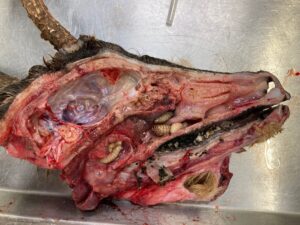Roe deer with deer botfly
At the end of June 2023, a roebuck in the province of Limburg was put out of its misery and collected for research by the DWHC in Utrecht. The roebuck had swollen front legs, had difficulty standing, did not flee when approached and was shaking a little with his head (tremor).
The roebuck was an adult. He was in a poor body condition due to a combination of several factors:
- Severe inflammation of nasal mucosa by larvae of the deer botfly (Cephenemyia stimulator). In the nasal cavity were more than 15 larvae of different stages of development (see picture), and also secretion of a secondary bacterial infection.
- Chronic inflammations in the joints and tendons of the front legs, the cause could not be determined. The cause the inflammation does not have to be of pathogenic, but could also be caused for example by abnormal behaviour to prevent infection with larvae or to try to get rid of the larvae.
- Over a hundred ticks, and some deer ked in the hide.
- Severe inflammation in the stomach due to roundworms (nematodes).

The deer botfly, also known as the deer nose botfly, is viviparous and spray live larvae (stage L1) into the nose. Roe deer can display panic behaviour when hearing the buzzing sound of deer botflies to prevent deposition of eggs. The deer can shake their head violently, run in circles or jump around.
Young larvae crawl into the nasal cavities. Infected roe deer sneeze, cough and shake their head in an effort to get rid of the larvae. They also scratch their noses with their legs. However, larvae have mouth-hooks to aid attachment, making it difficult for the deer to lose the larvae.
Deer botflies are quite common in roe deer and normally they cause no or little harm. This roe deer, however, also had other problems than just deer botflies. The inflammations in the joints and tendons of the front legs made standing difficult, and in combination with the lethargy made it impossible for the deer to run. Tremors in its head were likely caused by the botflies.



